Rheumatoid Arthritis Exercises: Joint-Friendly Workouts
What Is Rheumatoid Arthritis?

Rheumatoid arthritis is the most common form of autoimmune arthritis. It causes joints to become painful, tender, swollen, and stiff.
People with rheumatoid arthritis (RA) often have more than one joint affected by the condition. The same two joints on opposite sides of the body are frequently involved with RA. RA impacts small joints, which are found in the wrists, hands, and feet.
Although joint problems are the first things people recognize when it comes to arthritis, the disease of rheumatoid arthritis can impact other parts of the body as well. With RA, problems as follows may also occur:
- eyes become dry, painful, and red,
- the mouth becomes dry and gums are more easily irritated or infected,
- the skin can develop small lumps over bony areas known as rheumatoid nodules,
- blood vessels become inflamed, potentially causing nerve and skin damage,
- the number of red blood cells can drop, called anemia, and
- lungs can become inflamed and scarred, causing shortness of breath.
What Causes Rheumatoid Arthritis?
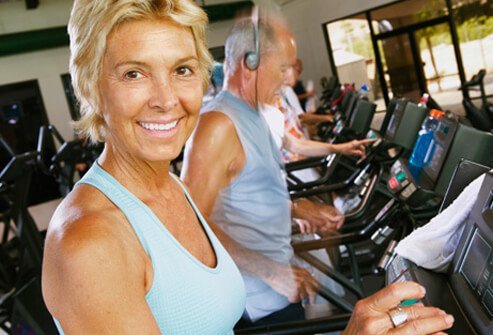
As an autoimmune disease, rheumatoid arthritis is caused by a misdirected immune system. With RA, the immune system attacks the body’s small joints. The precise reasons why this happens are unknown. Still, research suggests that the cause of rheumatoid arthritis is related to hormones, genes, and environmental factors, including
- female hormones (70 percent of RA sufferers are women),
- obesity,
- infectious agents like bacteria and viruses, and
- one’s physical and emotional response to stress and trauma.
Some other environmental factors may play a part in determining who gets RA, too, such as:
- air pollution,
- cigarette smoke exposure,
- insecticide exposure, and
- exposure to mineral oil or silica in the workplace.
Why Does Exercise Benefit Those With Rheumatoid Arthritis?

Exercise is considered the no. 1 non-drug treatment for people suffering from rheumatoid arthritis. Exercise has many benefits, including
- strengthening bones and muscles,
- delaying joint replacement,
- decreasing fatigue,
- lowering blood pressure,
- improving cholesterol levels,
- reducing pain, and
- improving movement and well-being.
With Rheumatoid Arthritis, How Often Should I Exercise?
Advice from your doctor is always best, so follow that first and foremost. The typical RA sufferer will need range-of-motion exercises to improve their long-term health.
In the following slides, we will guide you through some of the best exercises to protect your joints and help you get the most from your life while managing and reducing the pain, swelling, and immobility of rheumatoid arthritis.
Rheumatoid Arthritis: Swim Your Way to Fitness

Swimming is a great, low-impact way to exercise your body without intense joint pain. This is especially true with a heated pool. The water makes you feel great while you swim. Here are some steps to help you ease into a regular swimming routine:
- Begin slowly with a few minutes in a heated pool.
- Use a kickboard when you first adjust to moving in the water.
- Gradually build to a goal of swimming 30 minutes at a time.
Rheumatoid Arthritis: Sticking With Low-Impact Workouts

Low-impact aerobics are a central focus of treating rheumatoid arthritis. Start by choosing an exercise that fits you, such as
- stair climbing,
- walking,
- dancing, and
- low-impact cardio machines, like the elliptical trainer.
These exercises are better for you than activities that put stress on your joints, like running or playing basketball.
Another danger with rheumatoid arthritis is that it puts you at greater risk of bone loss (osteoporosis). For that reason, weight-bearing exercises like walking, dancing, and stair climbing are especially useful because they help strengthen your bones.
Isometric Exercises for Better Rheumatoid Arthritis Health

Isometric exercises are strength-training workouts in which the muscles contract, but the body doesn't move. Isometrics involve tensing a muscle, then relaxing it. This type of training is especially useful if the usual weight lifting causes your joints to hurt.
Some advantages of isometrics include:
- No need for additional equipment.
- The body is activating nearly all of its available motor units.
- Increased strength.
- Improved flexibility.
In the next several slides, we’ll show you some beneficial isometric exercises that can help you stay strong and healthy. While these exercises are less likely to hurt your joints than traditional weight training, if they do make your joints hurt, ask a trainer to show you another type of isometric exercise.
Rheumatoid Arthritis Exercise: Isometric Chest Press

To gain strength in your chest, follow these steps:
- With your arms at chest level, press the palms of your hands together as hard as you can.
- Hold for five seconds and then rest for the same amount of time.
- Do five repetitions.
- Slowly build up to holding the press for 10 to 15 seconds at a time.
- If it makes your joints hurt, ask a trainer to show you another type of isometric chest exercise.
Rheumatoid Arthritis Exercise: Isometric Shoulder Extension

This isometric exercise will help you develop greater shoulder strength. To do it correctly, follow these steps:
- Stand with your back against a wall and your arms at your sides.
- With your elbows straight, push your arms back toward the wall.
- Hold for five seconds and then rest.
- Repeat 10 times.
- If it hurts your joints, ask a trainer to show you another isometric shoulder exercise.
Rheumatoid Arthritis Exercise: Isometric Thigh Exercise
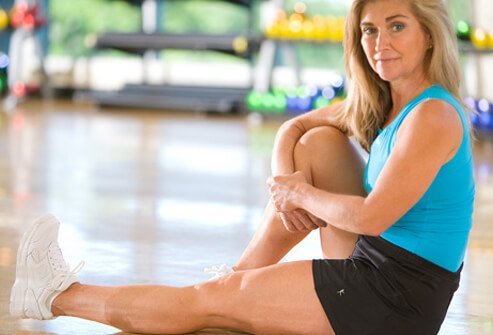
Get your thighs in shape with minimum joint pain by following these steps:
- Sit on the floor or a bed with one leg straight and the other bent.
- Tighten the thigh muscles of your straight leg as hard as you can and count to six.
- Relax, and then repeat.
- Do it with the opposite leg, gradually increasing up to five, then 10, then 15 repetitions, twice a day with each leg.
- If it hurts your joints, ask a trainer to show you another isometric thigh exercise.
Rheumatoid Arthritis Stretches: Improve Flexibility
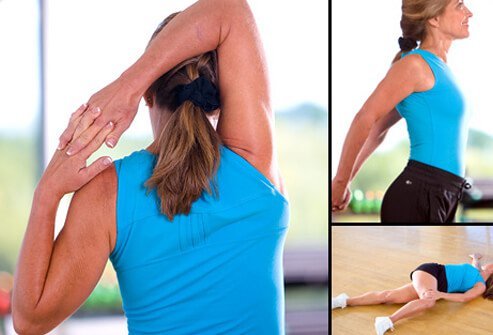
Gently stretching is a great way to ease the pain and stiffness of rheumatoid arthritis. It also helps increase your range of motion. Start each stretching session with a light three- to five-minute aerobic warm-up.
Hold stretches for 30 seconds without bouncing or jerking. It should feel good. Remember: keep it gentle, not intense.
In the next several slides, we’ll review some useful stretches that can help relieve your rheumatoid arthritis pain and stiffness.
Rheumatoid Arthritis Stretches: Stretch Your Fingers
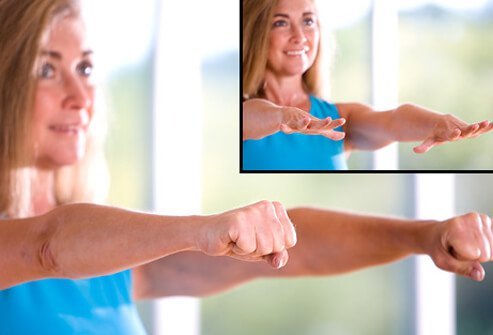
Since rheumatoid arthritis targets small joints such as the ones in your hands, this stretch can really bring some relief. To pull off the finger stretch successfully, follow these steps:
- Make a fist.
- Open and extend your fingers as straight as possible.
- Repeat this exercise, gradually increasing up to 20 times, twice a day.
- To add more challenge to this stretch, squeeze a foam or sponge ball about the size of a tennis ball, then release and extend your fingers.
Rheumatoid Arthritis Stretches: Keep Wrists Flexible

Another series of joints often hampered by rheumatoid arthritis are the ones found inside your wrists. To keep your wrists flexible, follow these steps:
- Sit at a table or desk.
- With your left forearm on the table, let your left hand hang over the edge.
- Use your right hand to grab the fingers of your left hand and bend your left hand at the wrist, slowly moving it up and then down as far as possible without pain.
- Repeat with the opposite hand.
- Increase up to 20 repetitions, twice a day.
Rheumatoid Arthritis Stretches: Try an Elbow Stretch

Keeping your elbows from getting stiff and sore is useful in all kinds of ways. To improve elbow flexibility, follow these steps:
- With your arm extended parallel to the floor, position your palm face-up.
- Use your opposite hand to grab hold of the fingers, and pull the palm of the extended hand toward the floor.
- Hold for 30 seconds.
- Now, do the same exercise, except this time turn your palm face down.
- Use the opposite hand to push the top of your extended fingers and hand down toward the floor.
- Hold for 30 seconds.
Rheumatoid Arthritis Stretches: Hip Rotation

Keep your hips flexible with this simple stretch:
- Sit or lie on your back on the floor or on a bed, feet slightly apart.
- With your legs and knees straight, turn your knees in toward each other and touch the toes of your feet together.
- Hold for five seconds.
- Turn your legs and knees out, and hold for five seconds.
- Repeat this twice a day, gradually increasing up to five, 10, and then 20 repetitions.
Rheumatoid Arthritis Stretches: Flexible Feet

Having flexible feet is useful for everyday living. Even walking becomes easier with more flexible joints in the feet. To keep toes and ankles more flexible, follow these steps:
- Face a wall and place your palms flat on it, one foot forward, and one foot back.
- Leave your heels on the floor and lean forward.
- You'll feel a gentle pull in the calf of your back leg and the Achilles tendon at the back of the ankle.
- Hold for 30 seconds.
- Do three repetitions.
- Then reverse the position of your legs and repeat.
Tai Chi and Rheumatoid Arthritis
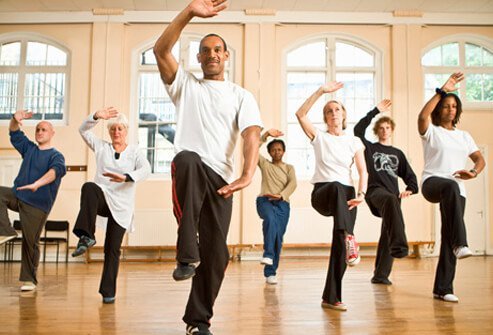
Tai chi is a gentle movement exercise that originated in China and is now practiced worldwide. In tai chi, practitioners work slowly and smoothly through a system of movements and postures that are meant to connect the body with the mind. In general, tai chi proponents point to the following health benefits:
- Greater strength
- Improved flexibility
- Improved balance
- Coordination
- Less stress and anxiety
- Better concentration and memory
- Better posture
Recent research studies suggest the following benefits of tai chi:
- Greater strength
- Better endurance
- Improved walking
Arthritis Australia and the Australian Rheumatology Association endorse a special set of 12 tai chi movements called Tai Chi for Arthritis, which were designed in 1997 specifically to help ease joint pain and stiffness for those with rheumatoid arthritis.
For Rheumatoid Arthritis Health, Avoid High-Impact Exercise

High-impact exercises put too much pressure on your joints if you suffer from rheumatoid arthritis. They can lead to flare-ups, increase the wear and tear on joints, and make daily life more painful and difficult. Unless otherwise advised by a doctor, try to avoid activities like
- jogging,
- running,
- tennis on hard pavement,
- lifting heavy weights,
- basketball, and
- indoor volleyball.
Balance Rest and Exercise for Rheumatoid Arthritis Relief

While staying active is one of the best forms of self-care for rheumatoid arthritis, remember that rest is also critical for ongoing health. When it comes to any exercise, follow these tips:
- Pace yourself
- Don’t overdo it
- If it causes pain, stop immediately
Lots of bedrest can help you feel better over the short term, but try not to overdo it. If you stay off your feet too much, your muscles get weak and your joint pain can actually get worse. The key here is balance.
Exercise for Rheumatoid Arthritis: Get a Personal Trainer

Learning to work out with rheumatoid arthritis can be a challenge. To make it easier and to get better results faster, look for a personal trainer with experience helping people with rheumatoid arthritis. Try to find someone who has worked with clients who have physical limitations, who are overweight, or who are senior citizens. A trainer like that will understand your unique challenges and be able to advise you about the workout routines that will work best for your body, and give you a sense of what equipment to try and what equipment and/or methods to avoid.

